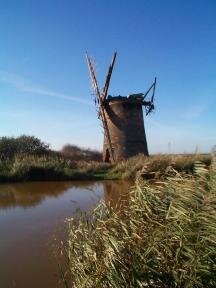
Organised by Pat Dandridge, nine South East Essex RSPB members set off for a four day birdwatching trip to North Norfolk. The North Norfolk coast is always an exciting place and this visit was to prove no exception.
Norfolk is perhaps the best county in Britain for all the year round birdwatching. More than 400 species have been recorded in the county. There are birds to be seen at any time of year with wildfowl in the winter months and also wintering raptors. Summer is a time to see some of East Anglia's scarce breeding birds. In particular, Norfolk offers breeding Avocets, Bearded Tits, Bitterns, Honey Buzzards, Marsh Harriers, Montagu's Harriers, Night jars, Stone Curlews and Woodlarks. It is for migration that Norfolk is the destination of birdwatchers, especially when there is a hint of east in the wind. The spring migration is more concentrated than the autumn migration. With most of the coast facing north, large falls of spring migrants are rare but every spring scarce and rare birds are found in Norfolk. Autumn is the best time of year to be birdwatching in Norfolk. Depending upon the weather conditions and, in particular the presence of winds with an easterly component, autumn migration can commence in mid August with warblers, chats and flycatchers and comes to a close at the end of November with finches, thrushes, wildfowl and owls arriving. Every autumn scarce birds are recorded in good numbers with rare birds being regularly found.
Thursday 1st November
The group set off from Southend in four cars and met mid-morning at Horsey Mere to try to find the Common Cranes.
Horsey Mere is situated on the eastern edge of the Norfolk Broads. This property of over 800ha (1900 acres) changes from sand dunes along the coastal edge through maritime fen and grazing marsh, arable farmland to the open water of Horsey Mere and its surrounding reedbeds. Horsey is a property of national and international importance as seen by the environmental designations: -
Candidate Special Area of Conservation (SAC), a European designation
Site of Special Scientific Interest (SSSI), a UK designation
Special Protection Area (SPA), a UK designation
At Horsey, a wide range of resident and over-wintering birds can be seen. Additionally, there is a small, natterjack toad colony plus a wide range of dragonflies and butterflies such as the Swallowtail that can be seen at the appropriate times of the year. Horsey Mere is the only one of the Norfolk Broads called a Mere. This is because it is the only one to be surrounded by a high level bank. The name is derived from the old Dutch word 'mere' meaning an artificial lake. The Estate was purchased in 1948 from the Buxton family, who still lease the farmland and are actively involved in looking after the estate.
Close to the car park is Horsey Windpump. With the artificially created mere, engineers constructed pumps at appropriate places on the surrounding wall, along with a series of drainage ditches or dykes leading to them in order to physically drain the land around. The land levels subsequently dropped as a result of this drainage so today the mere is on a higher level than its surroundings. Currently this system has only a single pump for the whole of the Horsey level. This pumping process is essential in maintaining the water level in the Mere and providing drainage to the surrounding farmland. The existing Windpump was built in 1911 to replace its predecessor, but in 1948, an electrically driven pump replaced it. The Windpump was severely damaged by lightning in 1943 but has since been restored.
The circular walk of Horsey was completed but, unfortunately, the Cranes were being secretive and no sightings were to be had. We then set off for the accommodation that was to be our base for the next three days.
Pat had arranged for us to stay in self-catering apartments at Denmark House at Weybourne run by Martin and Maureen Preston, this turned out to be a fantastic choice.
Weybourne lies on the North Norfolk coast at the western end of square TG14. More than 290 species have been recorded in this square with many occurring in Weybourne itself. The Sheringham Bird Observatory recording area lies just half a mile to the east. The marshes at Salthouse and Cley are to the west being three miles and five miles distant respectively. Blakeney Point is eight miles to the west. Kelling Heath and Salthouse Heath lie just a few miles to the south as does the heavily wooded Holt-Cromer ridge.
Martin and Maureen Preston are both keen birdwatchers and nature lovers. They are more than pleased to share their local knowledge and fully advise of local bird news. As they are resident on site they are available and pleased to assist in any way to ensure that any minor difficulties are quickly resolved and that their guests make full use of the accommodation and other facilities and enjoy their stay in Weybourne. The birdwatching at Denmark House is not intensive high pressure birdwatching catering only for the keen and knowledgeable birdwatchers, it is aimed for all ages and all levels of experience and beginners are especially welcome. The guests can spend time at Denmark House or 'do their own thing' and spend as little or as much time on the grounds as they choose. The property has even got its own nature reserve!
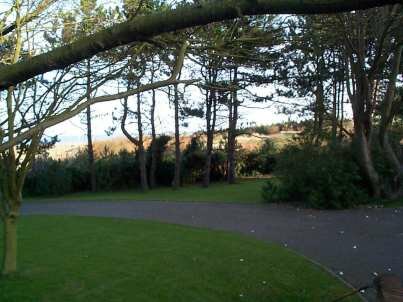
The magnificent grounds of Denmark House with the nature
Reserve and the sea beyond the trees
From October 1991 to the end of 1996 a total of 213 species have been recorded in or from the grounds. Some of the rarer or more unusual species recorded (some on several occasions) are as follows:
Bittern
Wryneck
Little Egret
Blyth's Pipit
Garganey
Waxwing
Honey Buzzard
Great Reed Warbler
Marsh Harrier
Sardinian Warbler
Montagu's Harrier |
Barred Warbler
Osprey
Yellow browed Warbler
Merlin
Firecrest
Hobby
Bearded Tit
Pectoral Sandpiper
Golden Oriole
Grey Phalarope
Red backed Shrike
|
Long tailed Skua
Great Grey Shrike
Iceland Gull
Serin
White winged Black Tern
Common Rosefinch
Long eared Owl
Hawfinch
Hoopoe
Lapland Bunting |
As well as migrant birds the numbers of breeding birds is steadily increasing. The breeding Warbler population is growing quickly and they have breeding Whitethroats, Lesser Whitethroats, Blackcaps, Willow Warblers, Reed Warblers and Sedge Warblers.
The grounds of Denmark House extend to approximately seven acres with most of this land lying between the house and holiday accommodation and the beach, with a smaller area lying to the south. When the land was purchased it consisted of nothing more than bare soil with the only trees and hedges being those around the buildings and some fifty yards of Hawthorn on the eastern boundary. In 1988 eight thousand trees and hedging trees and shrubs were planted and with continual additions over the last few years a total of approximately ten thousand trees have been planted. A pond and two wader scrapes have been constructed, and earth moving equipment has been brought in to create banks, behind which are planted trees which are now flourishing as they are sheltered from the salt laden winds that can occasionally blow with considerable force off the North Sea.
It is unlikely that the trees that have been planted will grow to any real size and will always remain as scrub. However this type of vegetation is particularly attractive to a large number of species of birds and insects. The guests are welcome to birdwatch in the grounds and in particular to make use of the three hides that overlook the wader scrapes. These hides afford an excellent opportunity to not only see waders at close quarters but many other birds visiting to drink and bathe. As these hides are private there is no limit to the time that can be enjoyed with a camera, camcorder or sketchbook.
Martin has a licence to catch and ring birds in the grounds to study migration, populations etc. and several thousand birds have been caught and ringed on the property. You may notice that nets may be occasionally erected for the purposes of catching birds to be ringed, and you will see a Heligoland trap on the eastern boundary which again is for the purpose of catching birds for identification, ageing, sexing (where possible) and ringing. The only restriction to general access is the private gardens of Denmark House (unless any rare bird appears there!). Guests are requested not to walk through the Heligoland traps and in addition, if ringing is taking place, in any part of the grounds access may be limited or accompanied. As well as attracting birds the efforts to create a wildlife reserve have been rewarded with good numbers of butterflies (25 species recorded to date), dragonflies and moths. Mammals are predominantly represented by the ubiquitous rabbit, whose numbers to a certain extent, are held in check by Stoats which you may see quite often. Hedgehogs are resident in good numbers but being mainly nocturnal are usually only seen in the late evenings. Roe Deer and Red Deer have been recorded on just three occasions.
The Holiday Accommodation
The accommodation stands in the grounds of the owners residence and consists of a modern flint dwelling that has recently been divided into two. The larger part of the accommodation 'THE PINES' sleeps six (plus one). The smaller part of the accommodation 'THE POPLARS' sleeps four (plus one) and is entirely on ground floor.
The price for our three nights stay was an incredible 25.00 pounds each!
Friday 2nd November
After a first light sea watch and breakfast we headed for Wells Next the Sea where a Sub-Alpine Warbler had been reported the previous day. The warbler was not sighted again but we had a very nice stroll down to the beach at Holkham. The afternoon saw us heading for the caf at Cley.
Cley Marshes is one of the best-known nature reserves in the country and is the oldest County Trust reserve, its purchase led to the formation of the Norfolk Naturalists Trust in 1926. Early in the year wildfowl numbers are high with widgeon, teal, mallard, shoveler and pintail being particularly abundant. Brent geese can be seen when food becomes scarce elsewhere and goldeneye, red-breasted merganser and long tailed ducks can be seen on the deeper pools.
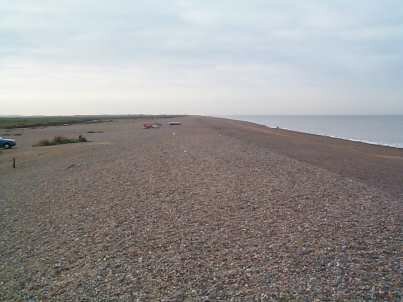
The long, long path to Blakeney Pont
Spring migrants include chiffchaffs, wheatears and sandwich terns. By the end of April the reedbed is full of reed and sedge warblers and parties of ruff and black tailed godwit may be observed. May is an exciting month with a succession of arctic-bound waders such as Kentish plover and Temminck's stint. Other spring-time surprises in recent years have included bee-eater, woodchat and tawny pipit. June may bring elegant visitors such as spoonbill, whilst the breeding birds include avocet, bittern and bearded tit. Ringed plover and oyster-catcher breed on the marsh perimeter and garganey, gadwall and shelduck nest around the deeper pools.
The autumn migration extends over many months and the pools are often alive with green and wood sandpiper, greenshank, whimbrel and little ringed plover. This reserve is much noted for its rarities and birds such as yellow browed warbler, wryneck and red breasted flycatcher are always a possibility. By early December most of the winter visitors have arrived and a new year starts.
The site lies about 15 km west of Sheringham on the north Norfolk coast. Leave Sheringham on the A149 coast road to Wells and travel for about 15 km, past the village of Salthouse and through a series of bends with open marsh land to the right. The car park and visitor centre are on the left. If you enter the village of Cley you have gone too far.
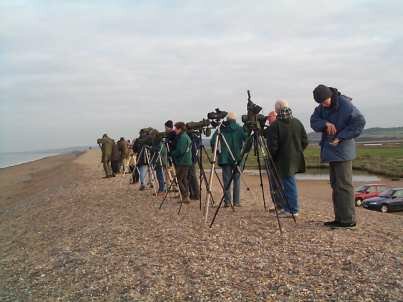
An appreciative audience for the Little Auks just offshore
Saturday 3rd November
After a quick walk down to the beach for our regular early morning sea watch we headed for the RSPB reserve at Titchwell. On the beautiful North Norfolk coast, 5 miles/8 km east of Hunstanton, Titchwell offers a wealth of birds throughout the year.
After a very enjoyable stay and a very long species list taking us over the 100 mark a few of us headed for the RSPB reserve at Snettisham and the late afternoon 'geese spectacular'. If you visit Snettisham at high tide during the autumn and winter, you will be treated to one of Britain's greatest wildlife spectacles. The Wash's rising tide pushes tens of thousands of wading birds and ducks up the beach and onto the reserve's pools. From November to early February, up to 40,000 pink-footed geese roost on the reserve. They are best viewed either early in the morning or late afternoon. At other times, many thousands of birds feed on the reserve and in the summer you can see nesting gulls and terns. Tide tables are available from the reserve.

Snettisham at dusk with the first of the Greylag Geese
We were not to be disappointed as more than 10,000 geese flew over our heads to roost on the Wash. The sight and sound was something that I know we will never forget.
Sunday 4th November
Our last day and our last chance to boost our species list. We decided on a walk along the shore at Salthouse.? This part of the north Norfolk coast is always exciting in spring and autumn, and Salthouse is no exception. Regular passage birds include wheatear, yellow wagtails, often around the hooves of cattle, and in most years have included the blue and grey-headed races. Other species regularly recorded include whimbrel, curlew, ruff and godwits, with occasional rarities such as broad-billed and Terek sandpipers, little whimbrel, red-throated pipit and rustic bunting. Wintering birds include Brent geese, snow bunting, occasionally shore lark and hen harrier and short-eared owl. Barn owls are to be seen throughout the year. The breeding birds include avocet, redshank, lapwing, meadow pipit, skylark, reed bunting, sedge and reed warblers and wildfowl. The avocet became extinct in this country in the 19th century, last breeding at Salthouse. By coincidence the first nesting of the avocet's return to Britain took place at Salthouse in 1941.
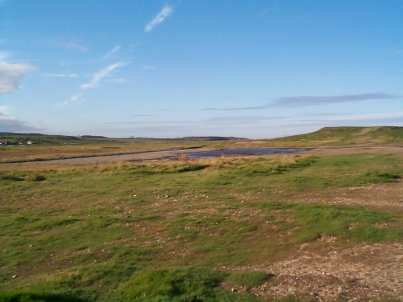
Salthouse and its Shore lark
The reserve may be viewed all year from the public footpaths through and around it. The reserve lies to the north of the A149 coast road, 2 km east of Cley and 7 km west of Sheringham.
After a very enjoyable walk we headed back for home.
Total species observed 105
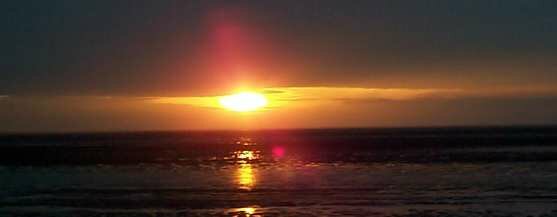
Snettisham with more than 10,000 geese in the sunset